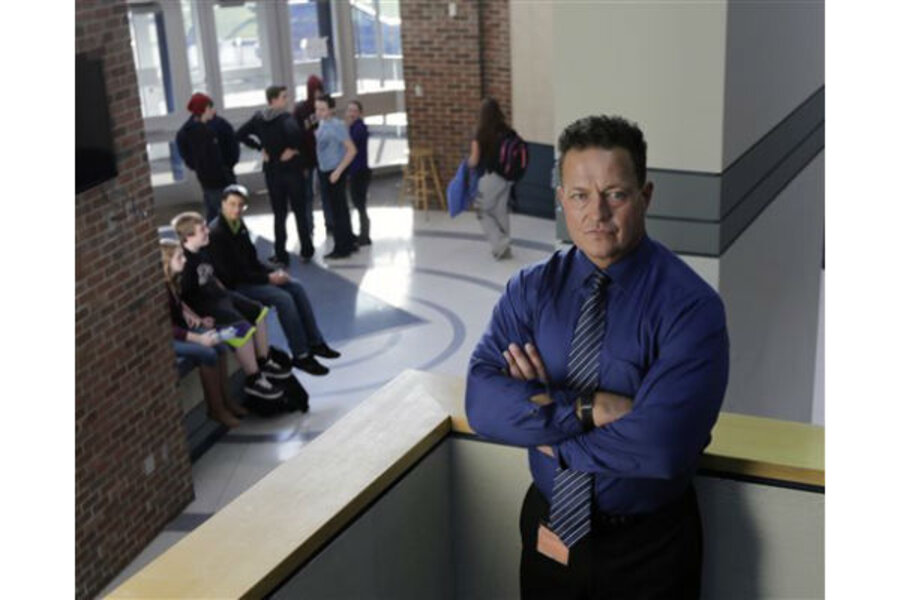Violence against teachers often ignored, task force says
Loading...
When a 16-year-old student slammed a metal trash can onto Philip Raimondo's head, it did more than break open the history teacher's scalp, knock him out, and send him bleeding to the floor.
"It changed my whole world," Mr. Raimondo said about the attack in the school where he taught for 22 years.
Experts say the phenomenon of student-on-teacher violence is too often ignored.
"There's some reluctance to think that the teaching profession can be unsafe," said Dorothy Espelage of the University of Illinois.
Dr. Espelage, an educational psychology professor, recently headed a national task force on classroom violence directed at teachers. The group found that little has been done to try to understand or prevent such incidents despite the potential implications on teacher retention and student performance, among other things.
But the October deaths, one day apart, of Nevada middle school math teacher Michael Landsberry, who was shot on a basketball court by a suicidal 12-year-old, and Massachusetts high school math teacher Colleen Ritzer, who authorities said was attacked by a 14-year-old student inside a school bathroom, have brought the issue to the forefront.
About 4 percent of public school teachers reported they had been attacked physically during the 2007-08 school year, according to the U.S. Department of Education, citing a 2012 school safety report. Seven percent were threatened with injury by a student.
A 2011 survey found that 80 percent of teachers reported being intimidated, harassed, assaulted or otherwise victimized at least once during the previous year.
Of the 3,000 teachers surveyed, 44 percent reported physical offenses including thrown objects, student attacks and weapons shown, according to the American Psychological Association Task Force on Violence Directed Against Teachers, which conducted the national web-based survey.
The task force recommended creating a national registry to track the nature and frequency of incidents, saying this would help develop plans for prevention and intervention. It also suggested that all educators be required to master classroom management before they are licensed to teach.
Raimondo, who taught in Buffalo, N.Y., was diagnosed with post-traumatic stress disorder and thought about suicide after suffering a concussion and other head injuries that required 32 staples and more than 40 stitches.
Unable to return to teaching, the history teacher who coached cross-country, girls' basketball and softball remains in therapy and on medication today, nearly 10 years later.
"I trusted kids," Raimondo said, becoming emotional as he told The Associated Press his story for the first time. "I loved what I did. For 22 years, that was my identity."
His attacker, one of two girls he had stopped from fighting, pleaded guilty to assault and was sentenced to up to six months in jail.
The National Education Association, the largest teachers' union, has reported anecdotal incidents of teachers being struck with a computer keyboard and of being "body slammed." One had hearing loss and blurred vision from a tossed M-80 explosive, the union said.
NEA President Dennis Van Roekel said that while school campuses remain safe places, more attention and resources should be directed at diagnosing and treating mental health issues and training educators in classroom management and safety.
"The big key is prevention," Van Roekel said.
In a sign of the times, the National Teachers Hall of Fame has begun raising funds for a granite memorial to fallen educators, to be built in Emporia, Kan.
"The reality is, it can happen anywhere," said Columbia High School Principal John Sawchuk, who in 2004 found himself wrestling a 16-year-old student for the loaded shotgun the boy used to wound a teacher in his East Greenbush, N.Y. school.
"That was the most terrifying moment of my life, something I will never forget," Mr. Sawchuk said. "I kept thinking, if I let go, he's going to kill me."
"You never really get over it. You try to learn from it," said Sawchuk, who added security officers, stepped up emergency drills and has stressed heightened vigilance since the shooting.
"We don't leave a stone unturned anymore," he said.
Diagnoses of post-traumatic stress disorder are not uncommon for victimized teachers, given the generally peaceful profession, said erald Juhnke of the University of Texas at San Antonio, an expert on the disorder.
"Teachers don't carry guns or badges," Dr. Juhnke said. "Teachers believe that they're safe in their environments for the most part, so when they experience violent behavior or threats it shakes them to the foundation – because they are there to help students."
Richard Iannuzzi, president of New York's largest teachers' union, said lesser disruptions from disrespectful students – mouthing off or refusing to take off a headset – are more troubling to teachers on a daily basis than is the threat of physical violence.
Teachers know what to do in those cases, he said. That's not always true when things escalate.
"When I worked in prisons, you had a panic button," Juhnke said. "Schools typically don't have that."





